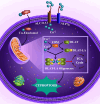Cuproptosis as the new kryptonite of cancer: a copper-dependent novel cell death mechanism with promising implications for the treatment of hepatocellular carcinoma
- PMID: 37843555
- PMCID: PMC11797724
- DOI: 10.1007/s00432-023-05456-w
Cuproptosis as the new kryptonite of cancer: a copper-dependent novel cell death mechanism with promising implications for the treatment of hepatocellular carcinoma
Abstract
Copper is an essential element for critical cellular functions such as mitochondrial respiration, cholesterol biosynthesis and immune response. Altered copper homeostasis has been associated with various disorders, including cancer. The copper overload is known to contribute to tumorigenesis, angiogenesis and metastasis, and recently it has been suggested that the elevated level of this element may also create vulnerability to a novel cell death mechanism, named cuproptosis. Excessive amount of copper in mitochondria binds to lipoylated enzymes of the TCA cycle and forms insoluble oligomers. The aggregation of these oligomers and subsequent iron-sulfur cluster protein loss results in proteotoxic stress and eventual cell death. Hepatocellular carcinoma is a common malignancy with a low survival rate, despite the available treatment options. The discovery of cuproptosis led many researchers to explore its potential use in hepatocellular cancer therapy due to the rich mitochondria content of hepatic cells. In this regard, a number of genomic studies were conducted to discover several cuproptosis-related genes and explored their association with prognosis, survival and immunotherapy response. This review brings together the available data on the relationship between cuproptosis and hepatocellular cancer for the first time, and highlights some of the potential biomarkers or target molecules that may be useful in the treatment.
Keywords: Cuproptosis; Hepatocellular carcinoma; Immunotherapy; Metastasis; lncRNAs.
© 2023. The Author(s), under exclusive licence to Springer-Verlag GmbH Germany, part of Springer Nature.
Conflict of interest statement
The authors declare that they have no known competing financial interests or personal relationships that could have appeared to influence the work reported in this paper.
Figures

Similar articles
-
Cuproptosis: a novel therapeutic mechanism in lung cancer.Cancer Cell Int. 2025 Jun 24;25(1):231. doi: 10.1186/s12935-025-03864-1. Cancer Cell Int. 2025. PMID: 40555995 Free PMC article. Review.
-
Management of urinary stones by experts in stone disease (ESD 2025).Arch Ital Urol Androl. 2025 Jun 30;97(2):14085. doi: 10.4081/aiua.2025.14085. Epub 2025 Jun 30. Arch Ital Urol Androl. 2025. PMID: 40583613 Review.
-
Copper metabolism and cuproptosis: broad perspectives in the treatment of hepatocellular carcinoma.Front Oncol. 2025 Jul 30;15:1555858. doi: 10.3389/fonc.2025.1555858. eCollection 2025. Front Oncol. 2025. PMID: 40809021 Free PMC article. Review.
-
The Black Book of Psychotropic Dosing and Monitoring.Psychopharmacol Bull. 2024 Jul 8;54(3):8-59. Psychopharmacol Bull. 2024. PMID: 38993656 Free PMC article. Review.
-
[Volume and health outcomes: evidence from systematic reviews and from evaluation of Italian hospital data].Epidemiol Prev. 2013 Mar-Jun;37(2-3 Suppl 2):1-100. Epidemiol Prev. 2013. PMID: 23851286 Italian.
Cited by
-
Cuproptosis: a promising new target for breast cancer therapy.Cancer Cell Int. 2024 Dec 19;24(1):414. doi: 10.1186/s12935-024-03572-2. Cancer Cell Int. 2024. PMID: 39702350 Free PMC article. Review.
-
Understanding the relationship between cuproptosis and the development of hepatocellular carcinoma: implications for targeted therapies.Front Immunol. 2025 Mar 12;16:1557223. doi: 10.3389/fimmu.2025.1557223. eCollection 2025. Front Immunol. 2025. PMID: 40145101 Free PMC article. Review.
-
Blood and Serum Copper and Zinc Levels and 10-Year Survival of Patients After Kidney Cancer Diagnosis.Nutrients. 2025 Mar 8;17(6):944. doi: 10.3390/nu17060944. Nutrients. 2025. PMID: 40289930 Free PMC article.
-
Biodegradable copper-iodide clusters modulate mitochondrial function and suppress tumor growth under ultralow-dose X-ray irradiation.Nat Commun. 2024 Sep 16;15(1):8092. doi: 10.1038/s41467-024-52278-6. Nat Commun. 2024. PMID: 39285181 Free PMC article.
References
Publication types
MeSH terms
Substances
LinkOut - more resources
Full Text Sources
Medical

